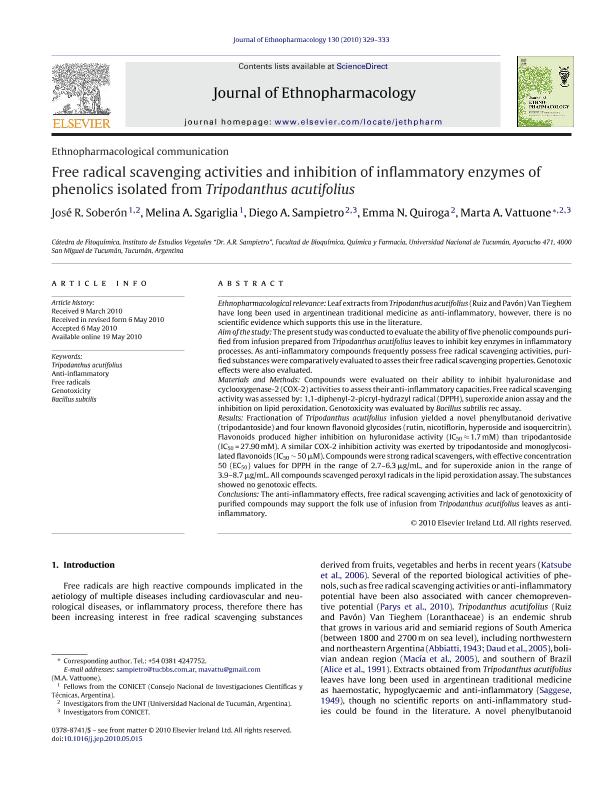Artículo
Free radical scavenging activities and inhibition of inflammatory enzymes of phenolics isolated from Tripodanthus acutifolius
Soberon, Jose Rodolfo ; Sgariglia, Melina Araceli
; Sgariglia, Melina Araceli ; Sampietro, Diego Alejandro
; Sampietro, Diego Alejandro ; Quiroga, Emma Nelly; Vattuone, Marta Amelia
; Quiroga, Emma Nelly; Vattuone, Marta Amelia
 ; Sgariglia, Melina Araceli
; Sgariglia, Melina Araceli ; Sampietro, Diego Alejandro
; Sampietro, Diego Alejandro ; Quiroga, Emma Nelly; Vattuone, Marta Amelia
; Quiroga, Emma Nelly; Vattuone, Marta Amelia
Fecha de publicación:
07/2010
Editorial:
Elsevier Ireland
Revista:
Journal of Ethnopharmacology
ISSN:
0378-8741
Idioma:
Inglés
Tipo de recurso:
Artículo publicado
Clasificación temática:
Resumen
Ethnopharmacological relevance: Leaf extracts from Tripodanthus acutifolius (Ruiz and Pavón) Van Tieghem have long been used in argentinean traditional medicine as anti-inflammatory, however, there is no scientific evidence which supports this use in the literature. Aim of the study: The present study was conducted to evaluate the ability of five phenolic compounds purified from infusion prepared from Tripodanthus acutifolius leaves to inhibit key enzymes in inflammatory processes. As anti-inflammatory compounds frequently possess free radical scavenging activities, purified substances were comparatively evaluated to asses their free radical scavenging properties. Genotoxic effects were also evaluated. Materials and Methods: Compounds were evaluated on their ability to inhibit hyaluronidase and cyclooxygenase-2 (COX-2) activities to assess their anti-inflammatory capacities. Free radical scavenging activity was assessed by: 1,1-diphenyl-2-picryl-hydrazyl radical (DPPH), superoxide anion assay and the inhibition on lipid peroxidation. Genotoxicity was evaluated by Bacillus subtilis rec assay. Results: Fractionation of Tripodanthus acutifolius infusion yielded a novel phenylbutanoid derivative (tripodantoside) and four known flavonoid glycosides (rutin, nicotiflorin, hyperoside and isoquercitrin). Flavonoids produced higher inhibition on hyluronidase activity (IC50≈1.7mM) than tripodantoside (IC50=27.90mM). A similar COX-2 inhibition activity was exerted by tripodantoside and monoglycosilated flavonoids (IC50∼50μM). Compounds were strong radical scavengers, with effective concentration 50 (EC50) values for DPPH in the range of 2.7-6.3μg/mL, and for superoxide anion in the range of 3.9-8.7μg/mL. All compounds scavenged peroxyl radicals in the lipid peroxidation assay. The substances showed no genotoxic effects. Conclusions: The anti-inflammatory effects, free radical scavenging activities and lack of genotoxicity of purified compounds may support the folk use of infusion from Tripodanthus acutifolius leaves as anti-inflammatory.
Archivos asociados
Licencia
Identificadores
Colecciones
Articulos(CCT - NOA SUR)
Articulos de CTRO.CIENTIFICO TECNOL.CONICET - NOA SUR
Articulos de CTRO.CIENTIFICO TECNOL.CONICET - NOA SUR
Citación
Soberon, Jose Rodolfo; Sgariglia, Melina Araceli; Sampietro, Diego Alejandro; Quiroga, Emma Nelly; Vattuone, Marta Amelia; Free radical scavenging activities and inhibition of inflammatory enzymes of phenolics isolated from Tripodanthus acutifolius; Elsevier Ireland; Journal of Ethnopharmacology; 130; 2; 7-2010; 329-333
Compartir
Altmétricas



